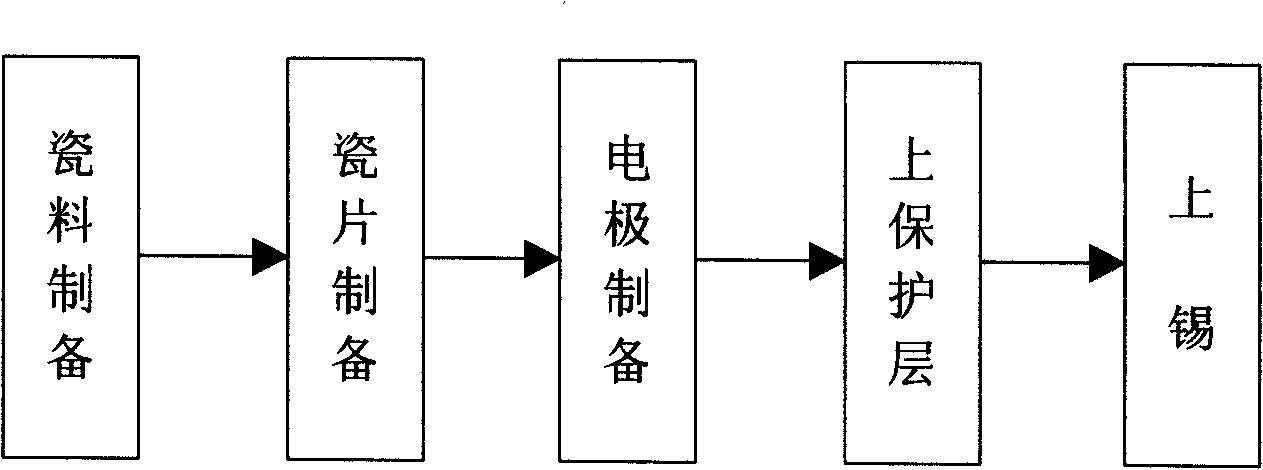Method for preparing heat impact resisting ceramic capacitor
A ceramic capacitor, heat-resistant technology, applied in the direction of capacitors, fixed capacitors, fixed capacitor electrodes, etc., can solve problems such as cracking, micro-cracks, difficult to meet the requirements of thermal shock resistance in the automotive industry, etc., to solve thermal stress and improve Effect of Thermal Shock Resistance
- Summary
- Abstract
- Description
- Claims
- Application Information
AI Technical Summary
Problems solved by technology
Method used
Image
Examples
Embodiment 1
[0017] Take the SrTiO3 ceramic material containing a small amount of Ta, Al, Si and add 30 grams of PVA material with a concentration of 25%, and then go through the process of rough rolling, intermediate rolling and finishing rolling to make the thickness of the diaphragm reach 0.8mm±0.03mm; punch the diaphragm into: Length 5.8±1mm, width: 4.8±0.5mm green sheet, the green sheet is deglued at 1100℃~1200℃ and atmospheric atmosphere for 2h±20min to make a degummed film; and then at 1450℃ and N2, H2 reducing atmosphere Under sintering for 3h. After the product is restored, use a 300-mesh nylon screen to coat the coating material containing Bi and Cu plasma on the surface of the product, dry it at 160°C to 180°C for 15 to 25 minutes, and then dry it at 1300°C and atmospheric conditions. Heat treatment for 2 hours, so that the coating material can completely penetrate into the interior of the porcelain body, fully wrap the grains, and insulate the grain boundaries. Thus, a capacit...
Embodiment 2
[0019] Take the SrTiO3 ceramic material containing a small amount of Ta, Al, Si and add 30 grams of PVA material with a concentration of 25%, and then go through the process of rough rolling, intermediate rolling and finishing rolling to make the thickness of the diaphragm reach 0.8mm±0.03mm; punch the diaphragm into: Length 5.8±1mm, width: 4.8±0.5mm green sheet, the green sheet is deglued at 1100℃~1200℃ and atmospheric atmosphere for 2h±20min to make a degummed film; and then at 1450℃ and N2, H2 reducing atmosphere Under sintering for 3h. After the product is restored, use a 300-mesh nylon screen to coat the coating material containing Bi and Cu plasma on the surface of the product, dry it at 160°C to 180°C for 15 to 25 minutes, and then dry it at 1300°C and atmospheric conditions. Heat treatment for 2 hours, so that the coating material can completely penetrate into the interior of the porcelain body, fully wrap the grains, and insulate the grain boundaries. Thus, a capacit...
Embodiment 3
[0021] Take the SrTiO3 ceramic material containing a small amount of Ta, Al, Si and add 30 grams of PVA material with a concentration of 25%, and then go through the process of rough rolling, intermediate rolling and finishing rolling to make the thickness of the diaphragm reach 0.8mm±0.03mm; punch the diaphragm into: Length 5.8±1mm, width: 4.8±0.5mm green sheet, the green sheet is deglued at 1100℃~1200℃ and atmospheric atmosphere for 2h±20min to make a degummed film; and then at 1450℃ and N2, H2 reducing atmosphere Under sintering for 3h. After the product is restored, use a 300-mesh nylon screen to coat the coating material containing Bi and Cu plasma on the surface of the product, dry it at 160°C to 180°C for 15 to 25 minutes, and then dry it at 1300°C and atmospheric conditions. Heat treatment for 2 hours, so that the coating material can completely penetrate into the interior of the porcelain body, fully wrap the grains, and insulate the grain boundaries. Thus, a capacit...
PUM
 Login to View More
Login to View More Abstract
Description
Claims
Application Information
 Login to View More
Login to View More - R&D
- Intellectual Property
- Life Sciences
- Materials
- Tech Scout
- Unparalleled Data Quality
- Higher Quality Content
- 60% Fewer Hallucinations
Browse by: Latest US Patents, China's latest patents, Technical Efficacy Thesaurus, Application Domain, Technology Topic, Popular Technical Reports.
© 2025 PatSnap. All rights reserved.Legal|Privacy policy|Modern Slavery Act Transparency Statement|Sitemap|About US| Contact US: help@patsnap.com


